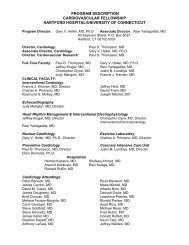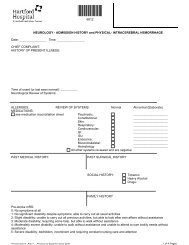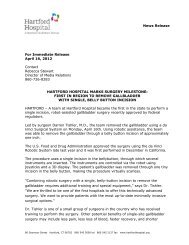Skin Cancer Risks in Transplant Recipients: Know the Facts
Skin Cancer Risks in Transplant Recipients: Know the Facts
Skin Cancer Risks in Transplant Recipients: Know the Facts
Create successful ePaper yourself
Turn your PDF publications into a flip-book with our unique Google optimized e-Paper software.
How quickly does sk<strong>in</strong> cancer develop after organ<br />
transplant?<br />
The majority of fair-sk<strong>in</strong>nned organ transplant patients will eventually develop<br />
sk<strong>in</strong> cancer. After a transplant, <strong>the</strong>re is generally a lag time of 3-7 years before<br />
sk<strong>in</strong> cancers beg<strong>in</strong> to develop. This period of time may vary depend<strong>in</strong>g<br />
upon <strong>in</strong>dividual risk factors. The longer a person takes immunosuppressant<br />
medications, <strong>the</strong> greater <strong>the</strong> risk of sk<strong>in</strong> cancer. In temperate climates 40% of fairsk<strong>in</strong>nned<br />
patients develop sk<strong>in</strong> cancer with<strong>in</strong> 20 years after transplantation. In<br />
warmer climates, up to 70% of fair-sk<strong>in</strong>nned patients develop sk<strong>in</strong> cancer with<strong>in</strong><br />
20 years after transplant.<br />
Can I lower my risk of develop<strong>in</strong>g sk<strong>in</strong><br />
cancer?<br />
You can’t change your sk<strong>in</strong>, but you can lower your risk<br />
of sk<strong>in</strong> cancer by follow<strong>in</strong>g <strong>the</strong> sun protection precautions<br />
outl<strong>in</strong>ed below. Also, all sk<strong>in</strong> cancer passes through a<br />
treatable phase before gett<strong>in</strong>g worse. Hav<strong>in</strong>g your sk<strong>in</strong><br />
cancer treated early is essential to ma<strong>in</strong>ta<strong>in</strong><strong>in</strong>g your health.<br />
Sun protection is <strong>the</strong> best strategy for prevent<strong>in</strong>g sk<strong>in</strong><br />
cancer. Unfortunately only 54% of transplant patients<br />
remember receiv<strong>in</strong>g sk<strong>in</strong> cancer education and only 40%<br />
regularly use sunscreen.<br />
To ma<strong>in</strong>ta<strong>in</strong> healthy sk<strong>in</strong> and prevent sk<strong>in</strong> cancer <strong>the</strong> follow<strong>in</strong>g measures are recommended:<br />
• Apply a broad spectrum sunscreen with a sun protection factor of at least 30 or higher.<br />
• Make sunscreen a part of your normal morn<strong>in</strong>g rout<strong>in</strong>e.<br />
• Cloth<strong>in</strong>g provides excellent protection from sun damage. Wear long sleeved shirt and long pants when possible.<br />
• Regularly wear a wide brimmed hat and sunglasses with UV protection.<br />
• Limit outdoor activity between 10 AM and 4 PM.<br />
Sunscreen <strong>in</strong> cosmetics is a good way to assure regular use. Apply <strong>the</strong> sunscreen to all exposed areas, <strong>in</strong>clud<strong>in</strong>g your face,<br />
ears, dry part of lip, neck and <strong>the</strong> back of your hands. Men with th<strong>in</strong> hair should apply it to <strong>the</strong>ir scalps.<br />
On <strong>the</strong> first day of each month you should do a self exam<strong>in</strong>e of your sk<strong>in</strong> with <strong>the</strong> help of mirrors or a partner. Look for<br />
any new or chang<strong>in</strong>g growths <strong>in</strong>clud<strong>in</strong>g p<strong>in</strong>k patches or spots, scaly growths, bleed<strong>in</strong>g areas or chang<strong>in</strong>g moles. Report<br />
<strong>the</strong>m to your dermatologist, physician or transplant coord<strong>in</strong>ator/nurse. Prompt attention can literally save your life.<br />
3

















